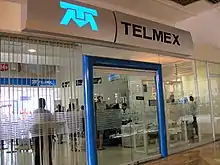Mass media in Mexico
Mass media in Mexico are regulated by the Secretariat of Communication and Transportation (Secretaría de Comunicaciones y Transportes or SCT), a federal executive cabinet ministry and by the Federal Telecommunications Institute (Instituto Federal de Telecomunicaciones or IFT).
| Telecommunications | |
|---|---|
 | |
| Telmex Retail Store in Puerto Vallarta | |
| Telephone land lines | 19.8 million (2011) |
| Mobile lines | 94.5 million (2011) |
| Telephone country code | + 52 |
| Internet Users | 31 million (2009) |
| Internet country code | .mx |
Mexico's communication services market is among the largest in Latin America,[1] liberalized in the 1990s, with the landmark privatization of Teléfonos de México (Telmex), a previously state-owned monopoly. Since then, new operators have entered the market, but Telmex remains the dominant player.
Regulation
Founded on 13 May 1891, as the Secretariat of Communications and Public Works, the SCT is divided into three subsecretariats: the Subsecretariat of Infrastructure, the Subsecretariat of Communications and the Subsecretariat of Transportation.
The SCT has ceded many of its regulatory functions to the Federal Telecommunications Institute.
Radio and television
Usage of radio, television and Internet in Mexico nowadays is prevalent.[2] The first television transmission in Mexico was conducted by Javier Stavoli in 1931. Guillermo González Camarena built his own monochromatic camera in 1934, and in 1940 he developed the first trichromatic system and obtained the first patent for color television in the world.[3] After developing radio and television stations, in 1948, he built the studio Gon-Cam, which was considered the best television system in the world in the time, according to survey conducted by the Columbia College of Chicago.[3]
With the passage of the century, the television broadcasting market became dominated by two powerful companies, Televisa—the largest Spanish media company in the Spanish-speaking world[4] — and TV Azteca, even though several dozen regional networks operate in the country. In addition, many states have their own television networks, and public television has increased its market penetration in recent years. In 2014 there were 1,762 radio stations and 1,063 separately licensed analog and digital television stations.[5]
Telephone and Internet
In general, the telecommunications industry is mostly dominated by Telmex (Teléfonos de México) and América Móvil.[6] The telecommunications industry was privatized in 1990 under the control of Grupo Carso and since 1996 under Carlos Slim.[6] Telmex has diversified its operations by incorporating Internet service and mobile telephony. It has also expanded its operations to Colombia, Peru, Chile, Argentina, Brazil, Uruguay, Ecuador and the United States.[7] Due to Mexican diverse orography—the country is crossed by two high altitude mountain ranges extending from the Rocky Mountains—providing landline telephone service at remote mountainous areas is expensive, and penetration of line-phones per capita is low compared to other Latin American countries, with 20 million lines.[8]
Mobile telephony has the advantage of reaching all areas at a lower cost, due to reduced investments in required infrastructure, and the total number of mobile lines in Mexico is nearly five times that of landlines, with an estimated 95 million lines.[8] The telecommunications industry is regulated by the government through the Federal Telecommunications Institute (IFT, Instituto Federal de Telecomunicaciones).
In April 2009, the ITESM (Instituto Tecnológico y de Estudios Superiores de Monterrey) reported 25,217,500 users; 78% of personal computer Internet access is broadband access.,[9][10] ranking ninth in the world.[11] November 2019, Spanish telecoms giant Telefónica signed a deal to use some of AT&T's infrastructure in Mexico.[12]
Satellite communications

The satellite system is domestic with 120 earth stations. There is also extensive microwave radio relay network and considerable use of fiber-optic and coaxial cable.[8]
Mexican satellites are operated by Satélites Mexicanos (Satmex), a leading private company in Latin America which services both North and South America.[13] Satmex offers broadcast, telephone, and telecommunication services to 37 countries in the Americas, from Canada to Argentina. Through business partnerships, Satmex provides high-speed connectivity to ISPs and Digital Broadcast Services.[14] The system is currently composed of three main satellites: Solidaridad 2, Satmex 5 and Satmex 6.
The Secretariat of Communications and Transportation is also in the process of deploying the Mexican Satellite System (MEXSAT), but a launch failure has postponed the project.
References
- Communications Markets in Mexico Archived 20 April 2008 at the Wayback Machine. EIU online store. Retrieved 9 April 2004
- Mexico Infrastructure, power and Communications. National Economies Encyclopedia. Retrieved on 13 January 2007
- Mexico. The Museum of Broadcast Communications. Accessed on 24 February 2007
- Televisa Brings 2006 FIFA World Cup to Mexico in HD With Snell & Wilcox Kahuna SD/HD Production Switcher – Snell & Wilcox
- IFT Distribution of Stations, November 2014
- "The World's Billionaires". Forbes. 7 August 2015. Retrieved 6 October 2016.
- Sobre Telmex Internacional Archived 15 May 2008 at the Wayback Machine. Teléfonos de México.
- Communications. Mexico. CIA Factbook.
- . Diario de Yucatán "Internet se arraiga en México". Accessed on 2 May 2009
- Todas las Primarias y Secundarias de Morelos tendrán Internet gratuito There are approximately 16.23 million internet hosts in Mexico
- Ranking of Internet Hosts. CIA Factbook. Accessed on 17 November 2012
- "Telefonica teams up with AT&T in Mexico in new bid to take fight to Slim". Reuters. 22 November 2019. Retrieved 25 November 2019.
- Satmex. Linking the Americas. Archived 15 September 2009 at the Wayback Machine Accessed on 24 January 2007
- Mexican Operator Satmex Has Chosen Arianespace to Launch Its New Satmex 6 Satellite. 14 February 2002. Spaceref.com. Accessed on 24 January 2007
Further reading
- Reuters Institute for the Study of Journalism, University of Oxford (2020), "Mexico", Digital News Report, UK, OCLC 854746354
{{citation}}:|author=has generic name (help)

.svg.png.webp)